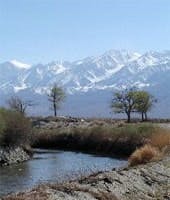Responding to an Inyo County Superior Court ruling, Los Angeles Department of Water and Power (LADWP) officials say they will move forward with implementation of the Lower Owens River Project (LORP) as quickly as possible.
"LADWP will fully cooperate with the ruling," said Ronald F. Deaton, general manager. "This is an exceptional project—one of the largest river restoration projects ever undertaken—and we are committed to seeing the water flowing again in the Lower Owens River, and to restoring a healthy riparian ecosystem."
In order to expedite the project and achieve the court-ordered deadlines, LADWP has proposed that it provide funding for Inyo County's portion of the LORP capital costs, and thus eliminate the need to obtain federal funding.
"We believe we can achieve the court's schedule if Inyo County accepts our offer to cover all of the capital costs for construction of the pumpback station,” Deaton said. "We are pleased that the judge rejected an argument by the Sierra Club and Owens Valley Committee to assess LADWP $32 million to create an environmental mitigation fund."
Instead, the judge imposed restrictions on Owens Valley groundwater pumping, and assessed a more reasonable penalty to ensure progress on the project.
The judge has imposed limitations on Owens Valley groundwater pumping, which initially will need to be offset by increased purchases of water from the Metropolitan Water District of Southern California, but the groundwater will be available for pumping in successive years.
LADWP had met its court-ordered deadline to complete the Environmental Impact Report, which was approved July 20, 2004 by the Los Angeles Board of Water and Power Commissioners. Rewatering and restoring of the Lower Owens River will prove to be one of the greatest environmental enhancements ever undertaken in the United States. The LADWP is proud of this exceptional project, and it wants to make sure it is done as soon as possible so that everyone can enjoy the benefits.
The main goals of the LORP are to create and sustain healthy and diverse habitats for native fish, waterfowl, shorebirds and other animals, as well as a warm water recreational fishery, through sound flow and land management practices which give nature the tools to produce healthy habitats.
In addition to providing a steady flow to 63 miles of the Owens River that has essentially been dry since it was diverted to Los Angeles in 1913, the LORP will spread water into basins to create hundreds of acres of wetland habitat and off-river lakes and ponds for waterfowl, shore birds and fisheries.
Source: Los Angeles Department of Water and Power


